Android

Created by Google, Android is a smartphone OS and platform that is open-source and open for any manufacturer to use to make a smartphone. Most Android phones use a version that is mostly provided by Google and requires Google services. Android phones can run Android apps, available from the Google Play Store, or, optionally, from other sources.
by: Google
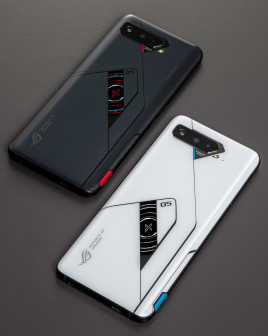
Asus ROG Phone 5 Maxes Out Specs, Adds a Rear Display
Asus today announced the ROG Phone 5, its newest flagship gaming phone, following the ROG Phone 3. The ROG Phone 5 brings the ROG Phone series up to date for 2021 with a Snapdragon 888 chip, Android 11, and 65-watt fast charging for its huge 6,000 mAh battery. The AMOLED display is also brighter and larger at 6.78 inches, and has an industry-leading 300 Hz touch sampling rate. The display specs are otherwise similar to the ROG Phone 3: 144 Hz refresh, HDR10+, and FHD+ resolution. The ROG Phone 5 will come in three versions. The standard model is available with 8 or 16 GB of RAM and 128 or 256 GB storage. A Pro model adds a small full-color display to the back, set at an angle, to show "customizable animations in response to a variety of system and in-game events". It's also available with up to 512 GB of storage. An Ultimate model steps up to 18 GB of RAM, and has a monochrome rear display. All three models use high-performance LPDDR5 RAM and UFS 3.1 storage. All three models also have sub-6 GHz 5G and will come in a North American version with support for nearly all of the 4G and 5G frequency bands used in the US, including band 77 for forthcoming C-band 5G networks. The ROG Phone 5 is the first in the series without an obvious air vent on the back for cooling, although Asus claims that its "GameCool 5" cooling system is "upgraded" to keep the processor from thermal throttling. The phone also has upgraded wireless, supporting Wi-Fi 6e and Bluetooth 5.2. A number of specs and features remain unchanged from the previous model, including the exact same array of cameras: 64 megapixel main, 13 megapixel wide, 5 megapixel macro, and 24 megapixel front camera. Other signature ROG Phone features remain, such as AirTrigger shoulder controls, front-facing stereo speakers, and an extra USB-C port on the side, for comfortable landscape gaming while charging. A 65W fast charger is included, and the phone also supports the Quick Charge 5.0 and USB-PD 3.0 fast charging standards. ASUS ROG Phone 5 series will be available in North America starting next quarter.
Apple Launches Tool to Copy Your Photos from iCloud to Google Photos
Apple has taken the unusual step of making it easier to switch from an iPhone to Android by launching a new web tool that helps you copy photos and videos stored in iCloud Photos to Google Photos. Available at privacy.apple.com, the service supports photos, videos, and basic albums, including a variety of file formats and "some" RAW files. The service does not support Smart Albums, Live Photos, and certain RAW files. Also unsupported are shared albums, photo stream content, and certain metadata. The process takes three to seven days, and Apple renames albums and videos to start with "Copy of ".
/e/ Starts Selling "De-Googled" Samsung Phones in US
Esolutions has started selling privacy-focused phones preloaded with the /e/ OS in the US. The /e/ OS is based on an open-source version of Android 10 (LineageOS, specifically) without any Google-controlled services that would enable tracking and data scanning by Google or third parties. /e/ replaces Chrome with its own Chromium-based browser, Gmail with K-9 Mail, and has its own app store and cloud storage service. Many popular third-party apps rely on Google Play Services for important functions like push notifications. /e/ OS includes a dummy API called MicroG to ensure such third-party apps don't crash, but those features like push notifications remain non-functional. Esolutions has offered phones pre-loaded with /e/ OS in Europe for some time, but has just started sales in the US for the first time. There are two refurbished Samsungs to choose from: a Galaxy S9 for $380, or a Galaxy S9+ for $430. The phones come with a one-year warranty and the e Foundation says "We aim to support with at least 3 years of software updates and security patches." The /e/ OS is also available for download for a number of other Android phones.
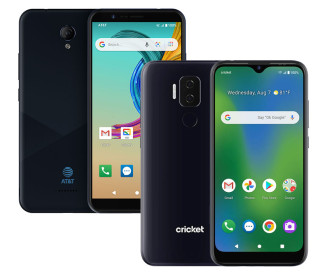
VinSmart Enters US Market with Two Sub-$100 Phones for AT&T
Vietnamese manufacturer VinSmart has officially entered the US phone market thanks to a deal with AT&T for "nearly 2 million smartphones". AT&T (and its Cricket prepaid brand) recently started selling two distinct entry-level phone models from VinSmart. Both are under $100 and are white-labeled, meaning they bear the AT&T or Cricket brand (instead of VinSmart or its Vsmart brand). AT&T has turned to Chinese manufacturer Tinno for such phones in recent years. But with the US government's hostile posture toward Chinese telecom companies in the last few years, AT&T may be looking to diversify its suppliers beyond China. The more affordable of the two models is the AT&T Fusion Z. It has a 6-inch HD display and USB-C, but its specs are otherwise minimal, including Android Go Edition, a Snapdragon 215 chip, and a 5 megapixel main camera. AT&T Prepaid shows the list price as $80 but is selling it for $40. Walmart is selling the same phone as the "Motivate" for $50. The slightly higher-end model is the Cricket Influence, which runs full Android 10 thanks to 3 GB of RAM and 32 GB of storage. It's powered by a Qualcomm Snapdragon 460 chip. Features include a fingerprint reader, modern notched HD display with Gorilla Glass 3, and a 13-megapixel camera plus depth camera for portrait mode. Both phones have a headset jack and memory card slot. Cricket shows a list price of $110 for the Influence, but is selling it for $40 to both new and existing customers. Walmart is selling the same phone for AT&T Prepaid as the AT&T Maestro Plus, for $90. The original "AT&T Maestro" was manufactured by Tinno.
Android Auto Adds Games, Wallpaper, Split-Screen View
Google is rolling out a major update to Android Auto. The new version includes car-optimized games such as trivia and "Jeopardy!". The feature can be activated by saying "Hey Google, play a game". Users can now "select from a variety of car-inspired backgrounds to personalize your car display". Finally, on "cars with wider screens", a new split-screen view "features a real-time view of Google Maps and media controls". The update will be available in the coming days for phones with Android 6 and above.

Google Now Lets You Schedule a Text in Messages
Google has started rolling out an update to it Messages app that lets users schedule a text message to send at a later time. The feature is designed for people with "loved ones in another time zone or on a different schedule". To use the feature, simply press and hold the send button to reveal a new pop-up menu for scheduling. The menu provides several suggested times as shortcuts, plus an option to pick any specific date and time. The feature will be available in the next Messages update for phones running Android 7 and newer.
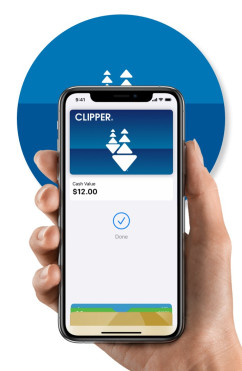
San Francisco's Clipper Transit Card Coming to Apple Pay, Google Pay
Clipper Card — the universal transit fare card for all 24 San Francisco Bay Area transit agencies — will be supported in Apple Pay and Google Pay digital wallets "this spring". Residents and visitors will be able to add a stored-value Clipper card to their digital wallet and tap their phones to ride transit, replacing a physical Clipper card. The system differs from those in cities (such as New York and Chicago) offering "open" fare payments made directly from a credit or debit card in Google Pay / Apple Pay. Apple has launched a page where people can sign up to be notified when Clipper is available for iPhone and Apple Watch. Separately, Google announced a new feature of Google Maps that lets users buy and present transit fare payments — including Clipper, when available — without leaving the Maps app, as part of turn-by-turn directions that include transit.

Android 12 Released to Developers
Google has released the first preview version of Android 12 to developers. As a developer release, it focuses on APIs and other developer-focused aspects, rather than necessarily representing the final look and feature set for consumers. Several new features are notable, though:
- Project Mainline continues to expand, with Google adding the Android Runtime (ART) module to the list of software that Google can update directly through the Play Store, instead of requiring a full OS update approved by manufacturers and carriers. ART handles compiling app code into processor instructions.
- Better support for newer image and video formats. Specifically, support for the AV1 image file format (AVIF), and better support for the HEVC video format.
- Rich content insertion, which makes it easier for apps to support copy-and-paste of styled text and multimedia. The new API for rich content also supports drag-and-drop.
- Haptic-coupled audio effect, which lets apps more easily add haptic effects by linking them to an audio channel.
- Multi-channel audio, including support for spatial information encoded with MPEG-H, and enabling apps to mix and process up to 24 audio channels.
- Finally, the Notification UI has been updated to make "custom" notifications look and work more like other notification types.
Essential Goes to Nothing
Nothing, Technologies, a new startup from former OnePlus executive Carl Pei, has purchased the Essential brand. Essential was a phone startup founded by Android creator Andy Rubin after he left Google.
Google Photos Gains New Video Editor, Plus Extra Features for Google One Members
Google today announced a new video editor as part of Google Photos. The company also announced that some advanced, AI-powered features previously available only on Pixel phones will now be available on more phones, but only for Google One subscribers. The new video editor adds features to "crop, change perspective, add filters, apply granular edits (including brightness, contrast, saturation and warmth) and more." This is in addition to existing features to trim, stabilize and rotate videos. It's available now in Google Photos for iOS, and "will be rolling out to most Android users in the coming weeks". In the coming months, iOS users will also get the revamped photo editor that rolled out to Android users late last year. Google One subscribers on Android will also get several new features that were previously restricted to Pixel phones. In the coming days, those users will see an updated Google Photos app that includes Portrait Blur, Portrait Light, and new "Dynamic" and "sky" filters. All of these new feature use machine learning to apply advanced effects in a realistic way to any photo, including those captured without depth information. Google One memberships start at $2/month.
Google Fi Extending Free VPN to iPhones
Google Fi today announced that its free VPN service is exiting beta for Android, and will "roll out ... to iPhone starting this spring." The VPN service protects against IP address tracking and hacking while using unsecure Wi-Fi networks.
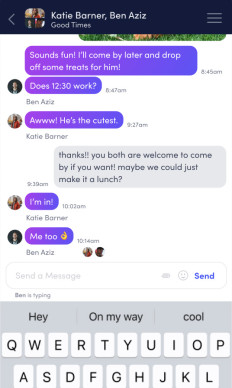
New Unified Messaging App Promises to Bring iMessage to Android
Beeper is a new $10/month app and service that unifies over a dozen different messaging services into one unified, searchable chat interface. It supports iMessage, Whatsapp, Facebook Messenger, Android Messages (SMS), Telegram, Twitter, Slack, Instagram, Skype, Discord, Signal, and more. It's available for iOS, Android, MacOS, Windows, and Linux. The service supports iMessage via one of two "bridge" methods: 1. the Beeper app running on a Mac that is always connected to the internet, or 2. "we send each user a Jailbroken iPhone with the Beeper app installed which bridges to iMessage". Beeper offers an open API called Matrix that enables bots, extensions, plugins, and integrations. The various "bridges" that power Beeper are open-source, enabling security audits as well as free self-hosting.
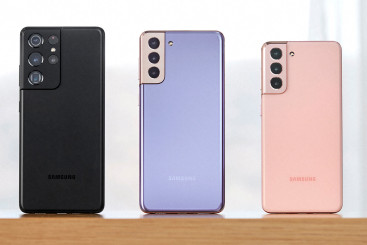
Samsung's Galaxy S21 Flagships are Prettier and More Affordable
Samsung today officially unveiled its Galaxy S21 series of flagship phones for 2021. All three models sport a distinctive new "Contour Cut Camera" design where the metal frame extends around one corner to surround the rear cameras. Each of the three new phones has a starting price a full $200 lower than last year's models. Samsung achieved this on the S21 and S21+ by reducing RAM from 12 to 8 GB and switching from curved QHD-resolution displays to flat FHD displays. Also, none of the S21 series has a memory card slot nor ToD depth camera. Naturally the processor has been updated on all models to Qualcomm's new flagship chip, the Snapdragon 888. Samsung is also using Qualcomm's new Gen 2. ultrasonic in-display fingerprint reader, which offers a 70% larger sensing area and is 50% faster. The phones ship with Android 11 and have a number of software improvements to the camera, such as Director's View, Vlogger View, and multi-mic recording. Samsung has also used AI to improve Single Take, Portrait Mode, and Space Zoom. The camera hardware on the S21 and S21+ is nearly identical to that on the S20 series. The S21 Ultra has the most-upgraded specs of the three, despite starting at a lower price than last year's model.
- Galaxy S21: The specs are very similar to last year's S20, including 4,000 mAh battery, 120 Hz refresh display, 64-megapixel main camera, 8K video capture, IP68 water resistance, fast wireless charging, and Wireless PowerShare. Unlike the S20, the S21 will come with mmWave 5G (including support for Verizon's "Ultra Wideband" network) from day one. It will come with 128 GB of storage, in Phantom Violet, Phantom Gray, Phantom Pink, and Phantom White, for $800. A 256 GB version will also be available in Phantom Gray for an extra $50. Phantom Gold and Phantom Red colors will be available exclusively from samsung.com.
- Galaxy S21+: Its 4,800 mAh battery is larger than that in both the S21 and last year's S20+. It also adds UWB for directional tag-finding and wireless car keys. This is the first time Samsung has put UWB in its S-series. It retains all of the other specs and features of the S21, with a larger 6.7-inch display like the S20+. It will come with 128 GB storage, in Phantom Violet, Phantom Silver, and Phantom Black, for $1,000. A 256 GB version will also be available in Phantom Black for an additional $50. As with the S21, samsung.com will be exclusive seller of Phantom Gold and Phantom Red colors.
- Galaxy S21 Ultra: This top-end model keeps the curved-edge, QHD-resolution display, 12 GB RAM, 108 megapixel main camera, and 40-megapixel front camera of last year's model, while adding several new features, all for a lower $1200 starting price. New this year is Wacom technology bringing full support for Samsung's S Pen, previously only offered on the Note series. The S Pen is an optional accessory. It also adds UWB, Wi-Fi 6e, adaptive display refresh from 10 – 120 Hz for power efficiency, and the ability to use 120 Hz refresh at QHD resolution. The telephoto camera system now includes dedicated 3x and 10x cameras, both 10 megapixel with OIS and dual-pixel auto-focus. All five cameras (front and back) can now shoot 4K video at 60 fps. The 108mp main sensor now has 12-bit HDR and can capture 12-bit RAW photos. It also has laser auto-focus. Pricing starts at $1,200 for 12 GB RAM / 128 GB storage in Phantom Silver or Phantom Black. Versions with 12 / 256 GB (for an extra $50) or 16 / 512 GB (for $1,380) will also be available, in Phantom Black only. Samsung.com exclusive colors will include Phantom Titanium, Phantom Navy. and Phantom Brown.
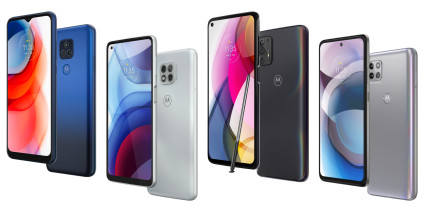
Motorola Unveils Full Affordable Lineup for 2021
Motorola today unveiled a full lineup of four new affordable phones, including three g-series models ranging from $169 – $299 and one 5G model for $399. All four feature large batteries (4,000 – 5,000 mAh) and large displays (6.5 – 6.8 inches). All four also include a fingerprint reader, multiple cameras, headset jack, memory card slot, USB-C connector, and a "water-repellant design" that protects against accidental spills, splashes, sweat, or light rain. They ship with Android 10 and Motorola promises one full OS version update plus two years of security updates. Moto's latest camera app supports AI scene detection and optimization, Google Lens, portrait mode, RAW format, Active Photos, Auto Smile Capture, Gesture Selfie, time-lapse, and slow-motion on all models. All four also support gestures such as Lift to unlock, Flip for DND (Do Not Disturb), Pick up to silence, and Fast flashlight, where a quick double-chop motion turns the flashlight on or off. All four phones will be available unlocked as well as from many US carriers.
- moto g play (2021): The most affordable at $170, this phone has a 6.5-inch HD display with notch, huge 5,000 mAh battery, Qualcomm Snapdragon 460 chipset, 3 GB RAM, and 32 GB built-in storage. Its primary 13 megapixel camera is assisted by a depth camera for portrait mode, and the front camera is 5 megapixel. It also has 10W fast charging. The new moto g play will be offered in the coming months by AT&T, Cricket, Boost Mobile, Consumer Cellular, Google Fi, Metro by T-Mobile, T-Mobile, Republic Wireless, Verizon, and Xfinity Mobile.
- moto g power (2021): Upgrades compared to the g play include: Snapdragon 662 chipset, 4 GB RAM, 64 GB storage, up to 15W fast charging, "48 megapixel" main camera that outputs 12-megapixel photos using pixel binning, 2-megapixel macro camera, and an 8-megapixel front camera. The upgraded main camera enables a Night Vision mode and better low-light performance in general. The camera app also gains Cinemagraph mode, Group Selfie, and Spot Color for video. The fingerprint reader moves to the side and the display is slightly larger at 6.6 inches, with a corner hole-punch design. This new moto g power will sell for $250, although Best Buy will sell a variant with 3 GB RAM and 32 GB storage for $200. It will also come to Boost Mobile, Cricket, Consumer Cellular, Google Fi, Republic Wireless, US Cellular, Verizon, and Xfinity Mobile in the coming months.
- moto g stylus (2021): This model adds a stylus that stows in the bottom-right of the phone. It comes with two special apps: Moto Note and Coloring Book. The stylus also offers system-wide shortcuts and works with third-party apps. This is the only model of the four to come with a smaller 4,000 mAh battery, which Motorola says was necessary to make room for the stylus. It has several spec upgrades compared to the g power, including a larger 6.8-inch display with full-HD resolution, Snapdragon 678 chipset, 128 GB storage, 8-megapixel wide-angle camera, 16 megapixel selfie camera, and 4K video capture. It will sell for $300 unlocked. Boost Mobile, Cricket, Consumer Cellular, and Republic Wireless will also offer it in the coming months.
- Motorola one 5G ace: Combines the best of the g power and g stylus specs (minus the stylus) while adding 5G (sub-6 GHz only) thanks to its Snapdragon 750G chipset. Other upgrades include 6 GB RAM, NFC, and an official IP rating for water resistance: IP54 for the T-Mobile version and IP52 for other versions. The display measures 6.7 inches with a centered hole-punch design, and the fingerprint reader is located on the back. It will run $400 unlocked. AT&T, Consumer Cellular, Google Fi, Metro by T-Mobile, T-Mobile, Republic Wireless, Verizon, and Xfinity Mobile will also offer it in the coming months.













